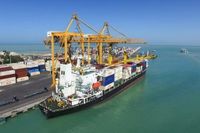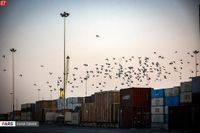In a significant boost for Iran's economy, the country has reported notable increases in non-oil exports, showcasing resilience in its trade sector despite ongoing economic challenges. Hojatollah Chavoshi, the caretaker of Parviz Khan Customs, revealed that the customs processed $666 million worth of declared goods and $330 million in transit goods, marking a 3% increase in export value and a 4% growth in volume compared to last year. Chavoshi explained that, on average, 690 export trucks traversed the customs checkpoint daily, highlighting the active trade flow.
The exported commodities from Parviz Khan, which is one of Iran’s largest trade hubs, predominantly included fruits and vegetables, evaporative coolers, construction materials, steel billets and sheets, rebar, and a variety of dried fruits. Chavoshi emphasized the pivotal role of Parviz Khan Customs, which manages the daily movement of over 2,000 trucks. Kermanshah Province, where the customs is located, shares a 371-kilometer border with Iraq and hosts two official border points along with five operational border marketplaces. Notably, Parviz Khan accounts for 45% of Iran’s non-oil exports to Iraq, facilitating trade with key Iraqi cities such as Sulaymaniyah, Kalar, Khanaqin, Kirkuk, and Mosul.
In a parallel development, the value of non-oil exports from Bushehr province, situated in the southwest of Iran, has surged by 12% in the past Iranian calendar year, which ended on March 20. According to Arsalan Zare, the governor-general of Bushehr, over 30 million tons of non-oil products worth $12 billion were exported from the province during this period. Additionally, the province imported 900,000 tons of non-oil commodities valued at $2.8 billion.
These figures contribute to a broader picture of Iran's non-oil trade, which has shown resilience in the face of economic sanctions and global market fluctuations. According to Abolfazl Akbarpour, the deputy head for planning and international affairs at the Islamic Republic of Iran Customs Administration (IRICA), Iran exported over 152 million tons of non-oil goods worth $57.8 billion in the past Iranian calendar year, marking a 10% increase in volume and a 15.62% rise in value compared to the previous year.
Despite these increases, the country faced a non-oil trade deficit of $14.6 billion, largely due to the import of over $8 billion worth of raw gold bars, which accounted for 11.12% of the total import value. Iran's main non-oil exports included natural gas, liquefied propane and butane, methanol, liquefied petroleum gases, and hydrocarbon gases. Natural gas emerged as the top export item, with an average customs value of $314 per ton.
The top destinations for Iran’s exports were China, receiving $14.8 billion, followed by Iraq at $11.9 billion, the United Arab Emirates at $7.2 billion, and Turkey at $6.8 billion. Other significant partners included Pakistan and Afghanistan at $2.4 billion each, and India at $1.9 billion. Collectively, these seven countries accounted for $47.6 billion, or 82.3% of Iran’s total non-oil export value.
On the import side, essential goods such as corn feed, soybean meal, genetically modified soybeans, rice, and sunflower seed oil were among the top items. Smartphones, tractors, and auto parts also featured prominently in Iran's imports. The United Arab Emirates was Iran’s largest source of imports at $21.9 billion, followed by China at $19.3 billion, Turkey at $12.4 billion, and Germany at $2.4 billion. Together, these countries supplied goods worth $60.7 billion, or 83.8% of Iran’s total imports.
In light of these developments, officials have emphasized the need to improve the facilities and equipment at provincial customs offices to enhance their operational capacity. Zare pointed out that given the privileged position of the Bushehr customs offices in earning foreign currency income, it is crucial to elevate the level of their activities.
As Iran continues to navigate through economic challenges, the reported increases in non-oil exports from both Parviz Khan and Bushehr provinces reflect a potential upward trend in the country’s trade dynamics. The strategic importance of these customs points, particularly in facilitating trade with neighboring Iraq, underscores their role in Iran's economic landscape.
With ongoing discussions about enhancing trade relations and improving export capabilities, the future may hold promising opportunities for Iranian businesses. As the country seeks to bolster its economy through increased non-oil exports, the focus on key border points like Parviz Khan and Bushehr will likely remain a priority for officials aiming to strengthen Iran's position in regional trade.
As the world watches, Iran's efforts to enhance its trade relations could serve as a model for other nations facing similar economic challenges, showcasing the importance of strategic trade hubs in fostering economic resilience.





